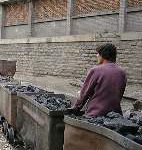Fly ash, a residue generated by the combustion of coal, is China’s single biggest source of solid industrial waste and, according to Greenpeace, one of its gravest problems. The international campaign group has brought out a new report on the substance, also known simply as coal-ash, in which it argues that China has severely underestimated the extent of the crisis. Not only are the quantities rising, it says, but there is no control over the long-term pollution the ash creates.
“China’s fly-ash problem is unique,” says Yang Ailun, climate and energy campaigner with Greenpeace. “It is an inevitable consequence of coal-fired power generation, since every four tonnes of coal burned produces one tonne of ash. Since 2002, when China started a rapid expansion of its coal sector, coal ash production has gone up two and a half times.”
On September 15, Greenpeace China published “The True Cost of Coal – an investigation into coal ash in China”. The report estimates the country produced 375 million tonnes of coal ash in 2009 – more than twice that year’s total urban-waste production. In terms of volume, that’s 424 million cubic metres a year, enough to fill a standard swimming pool every two and a half minutes. If this waste is not dealt with appropriately, it will become a grave threat to the environment and to public health.
According to the report, China meets 70% of its energy needs through coal, with electricity generation accounting for half of all coal consumption. The heavy metals and radioactive substances present in coal remain in the ash, where they exist in higher concentrations.
Between January and August this year, Greenpeace surveyed the coal ash disposal sites of 14 Chinese power plants. According to the report, more than 20 different toxic substances, including heavy metals and chemical compounds harmful to human health and the environment were found. Although concentrations of heavy metals and other substances are lower than in other forms of industrial waste, the sheer quantity of coal ash produced means the actual quantities of harmful substances released into the environment are still substantial. But as the impact of the ash on the environment and human health takes time to emerge, it is easily overlooked.
Yang says: “The choice of location and measures to prevent wind dispersal, leakage and run-off were entirely inadequate to stop pollution at the majority of the coal ash disposal sites we examined. Toxins in the ash are already polluting the local soil, air and water, harming not just the health of local people but, through the food chain, also threatening the wider population.”
Greenpeace’s investigations found that both surface and well water around many coal power plants did not meet official standards.
Coal ash impoundments are also taking up an increasing amount of land, says the NGO. The majority of those surveyed are much closer to nearby villages than the 500 metres stipulated in the government’s standards on storage and disposal of industrial solid waste. The coal dam at Douhe Power Plant in Hebei province, north China, is a mere 50 metres away from the village of Lijiayu. And the Fengzhen and Yuanbaoshan power plants, both in Inner Mongolia, are close to milk collection points that belong to a well-known dairy firm.
The head of Greenpeace China’s climate and energy campaign, Zhao Xingmin, told chinadialogue: “We didn’t do any specific tests, but since we know that the health of dairy cows is affected – demonstrated by lower milk production and birth rates – we expect that, even if the effects are slow, the toxins will be passed from the cows into the food chain.”
According to the report, villages and fields near the impoundments have also been affected by dispersed ash. The Greenpeace team met villagers complaining of skin and respiratory disorders near all of the sites. In some areas, cows and sheep were found to be suffering from diarrhoea, reduced fertility and higher mortality rates after eating grass polluted with coal ash.
Large quantities of ash blown onto fields has also increased salinity and alkalinity, and pollution of groundwater by run-off from the impoundments forced villagers to find new sources of drinking water, with some having no choice but to buy expensive bottled water. In certain cases, the weight of the stored coal had increased groundwater pressure, deforming the foundations of nearby homes and making them uninhabitable.
The report highlights another potential danger-point. If rainstorms or floods caused landslides at the sites of the impoundments, then the tens of thousands of tonnes of stored coal ash – containing heavy metals and other toxins – would present a serious threat to both public health and the environment. Such disasters have happened before. In June 2006, a leak from the coal dam at Pan County Power Plant in Guizhou, south-western China, sent 300,000 tonnes of coal ash into the Tuochang River.
The Greenpeace report says that, in accordance with central government requirements, many local governments have set a provincial or municipal target of reusing 60% of the fly-ash produced. Both central and local government have put preferential policies in place accordingly, such as funding or tax breaks for projects using coal ash. But Yang Ailun is not convinced by the figures. “The issue of coal-ash pollution has never received the attention it deserves,” she says. “The biggest misconception is the belief that 60% or more of China’s coal ash is reused – in reality it’s less than 30%.”
The main cause for this is poor quality, weakly-implemented and non-binding legislation, and a failure to consider the unique scale of the issue, argues Greenpeace. Also, the Ministry of Environmental Protection’s coal ash discharge fee of 30 yuan per tonne is an ineffective deterrent.
The report also says that toxic trace elements and radioactive substances are present in products made from the ash, such as concrete, bricks and paving stones, where they will continue to present a threat to the environment and human health. But current Chinese policy means that these products are not treated as solid waste, and therefore environmental law is not applicable. There is also a lack of specific and effective regulation for protecting health and the environment – yet another risk for China.
Meng Si is managing editor in chinadialogue’s Beijing office.
Homepage image from Greenpeace China


